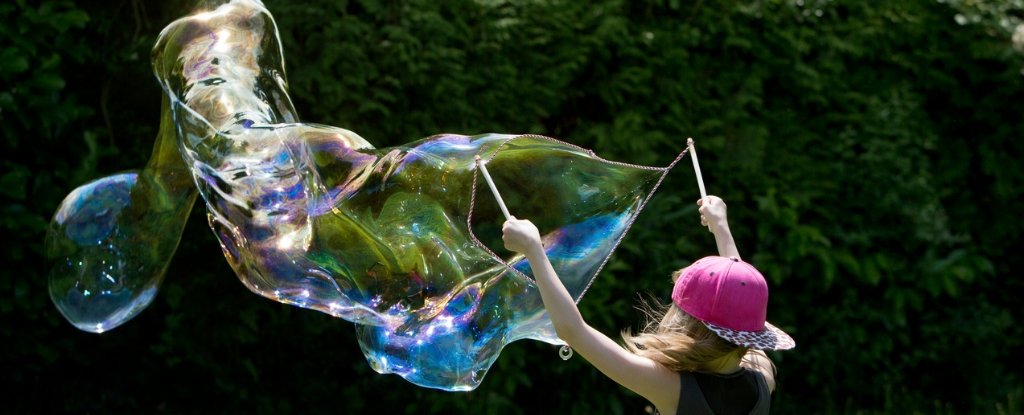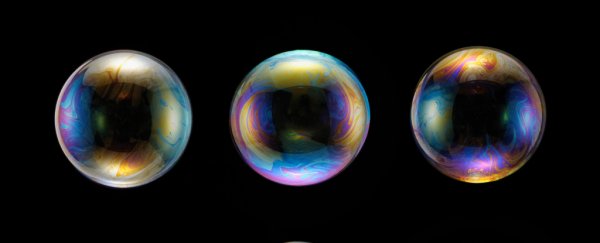With the right patience and finesse, you can get soap bubbles to grow to enormous sizes. At their most gigantic, with surface areas approaching 100 metres squared (over 1,000 square feet), these globules can get large enough to hold entire cars within their fragile grasp.
Stretched out to extreme lengths, a bubble's microscopically thin walls will begin to glisten like a rainbow, which raises the question: how can something just a few microns thick, roughly as wide as a wavelength of light, exist without exploding?
After more than a year of research, physicists at Emory University have figured out what makes the perfect gigantic bubble so stable.
The absolute Goldilocks of bubble mixtures, they say, is one that gives a bit of stretch, allowing the fluid to flow a little, but not too much that it runs amok.
"We basically started making bubbles and popping them, and recorded the speed and dynamics of that process," says physicist Justin Burton.
"Focusing on a fluid at its most violent moments can tell you a lot about its underlying physics."
 (Elva Etienne/Moment/Getty Images)
(Elva Etienne/Moment/Getty Images)
Time and time again, the best bubbles came from solutions of water and soap that also contained polymers - a substance with a long chain of repeating molecules, usually found in lubricants.
This was the same advice the team had found when they consulted the Soap Bubble Wiki, an online resource for "bubblers" trying to create "the perfect bubble".
Taking these recommendations into account, physicists were able to validate some of the techniques this online community has already been using.
With their long strands tangling together, Burton says polymers can act like a 'hairball' in soap solution, stopping the walls from breaking apart.
By complete mistake, the authors also found that if the polymer strands had more varying lengths, the bubble was sturdier. Using slightly aged lubricants, where the molecular strands had begun to degrade to different extents, the authors noticed they were producing better bubbles.
"Polymers of different sizes become even more entangled than single-sized polymers, strengthening the elasticity of the film," explains Burton.
"That's a fundamental physics discovery."
It's hard to say who's more obsessed with bubbles, physicists or children. For decades, researchers have blown bubble after bubble, hoping to figure out how the underlying fluid dynamics really work.
At super low temperatures, for instance, experts have found soap bubbles turn into tiny little snow globes, as various parts of the sphere freeze at different times.
Investigations like this have even allowed us to describe the fascinating properties of antibubbles, which are droplets of liquid surrounded by gas, as opposed to the other way around.
"The processes of fluid dynamics are visually beautiful and they are everywhere on our planet," says Burton, "from the formation and breakup of droplets and bubbles to the aerodynamics of airplanes and the deep-sea overturning of the world's oceans."
Learning how these globules work at a fundamental level could help us to improve the flow of oil through industrial pipes, or allow us to clean up foam pollution in streams and rivers. In a world filled with water, the possibilities are endless.
"As with all fundamental research, you have to follow your instincts and heart," Burton says.
"Sometimes your bubble gets burst, but in this case, we discovered something interesting."
The team's recipe for gargantuan bubbles, found in the video above, is as follows:
Combine half a heaping teaspoon of guar powder with three tablespoons of rubbing alcohol. Mix out the clumps, combine with 940 millilitres of water, and then stir gently for 10 minutes.
Let this sit a few minutes to let the guar hydrate, then stir until it thickens. Add in half a teaspoon of baking powder, followed by three tablespoons of washing-up detergent. Be careful to keep the foaming down as you mix. Build a big bubble wand from a fibrous material, and go wild!
The study was published in Physical Review Fluids.
